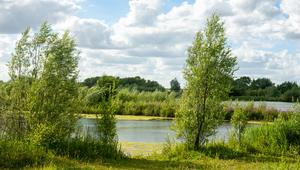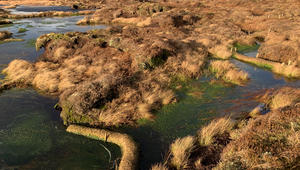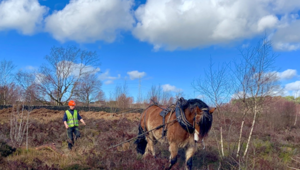We need to embrace our wilder side - and there are signs of progress, writes Sam Herbert.
25 March 2024
Yorkshire and the Humber is home to some of the UK’s most beautiful and rare habitats. Chalk streams flowing through the Hull catchment are mineral rich and provide the perfect conditions for wildlife to thrive. Visit one and you might encounter water-crowfoot, Atlantic salmon, white-clawed crayfish, dragonflies, mayflies and a multitude of insects to add some colour to your day.
Our dramatic Yorkshire coastline is a preferred breeding ground for kittiwakes, gannets, razorbills and, of course, the perfect place to catch a glimpse of the enigmatic puffin. If you’re lucky you might see a grey seal pop up to say hello or a pod of bottlenose dolphins swim by too. We’ve got protected meadows filled with rare flowers, magical ancient woodlands, heather-covered moors and wetland oases, and they all provide vital habitat for our native wildlife and beautiful, calming retreats for us to escape to.
But these treasures are much too few and much too small. If we step back and look at the wider context, we see a very different picture.
Globally, we’ve experienced a 69% decrease in wildlife populations since the 1970s and the UK is one of the most nature-depleted countries in the world. The majority of our UK rivers are polluted, overused and often undervalued. We’ve managed the diversity out of 97% of our grass and meadowlands since the 1930s, often leaving bereft monoculture deserts or barren soils in their place. In the name of ‘progress’, we’ve torn down our woodlands and industrialised our seas. Plants and animals introduced from overseas dominate our landscapes, pushing out native life, and we’ve hunted and persecuted many of our birds, large herbivores, keystone predators and, our beloved, charismatic beavers to extinction. In the process of our economic development we have forgotten that our existence depends on the ecosystems we are part of. The repercussions of the damage we have done are now frighteningly clear. We are on the brink of catastrophic ecological collapse. Dramatised as it may sound, the reality of our situation is dire. Our choices now are not just about saving the trees and birds, they are also about saving ourselves.
New insights
Today, we at the Yorkshire and Humber Climate Commision have published our Insight Paper on Nature’s Recovery. In it, we pull together expertise from regional and national experts on nature, our panel members and Commissioners to explore the opportunities for how our region can lead the way in the protection and restoration of native wildlife. We summarise the current state of nature in the UK and, where data permits, in Yorkshire and the Humber, as well as discussing some of the initiatives already regenerating our region’s habitats. Finally, we outline recommended actions that could help to accelerate progress and turn the tide on biodiversity loss whilst creating more opportunities for us to enjoy and benefit from a stronger connection to our natural world.
By embracing a wilder perspective and respecting our plant and animal co-habitors as the perfect companions they are, there is huge opportunity for our region to lead the way in transformative action for nature.
Embracing our wilder side
The answer to this crisis is not complicated, but it does mean significant changes and that in turn makes it feel difficult. In the words of Sir John Lawton, we need “more, bigger, better and joined up,” healthy habitat for our non-human friends. In part, this will mean protecting more land and sea as designated wild spaces, but it also means we must re-learn our place in nature and reconnect with our natural environment. And whilst finding more space for nature in our gardens, cities, farms and industries may present many barriers, the benefits of these changes will far outweigh the challenges in getting there. Bringing nature back into our urban spaces means more access to greenery, cleaner air, natural shade and shelter. Nature-friendly farming can improve soil quality, manage surface water and build resilience into food production for the long-term. There are also economic drivers and incentives for our business leaders. Putting nature at the heart of business can attract investors and increase market share, create resilience in supply chains, and in turn reduce costs of waste management and risks of noncompliance with environmental regulations.
There is progress. We’re seeing nature getting more of a voice in the media and the passions of high-profile celebrities like Sir David Attenborough, Chris Packham and Hamza Yassin are rekindling a love for nature in mainstream audiences. The government’s commitment to a Nature Recovery Network across the UK, delivered through Local Nature Recovery Strategies which are being written as I type this blog, is a huge step forward in how nature is recognised in UK policy. The 30 by 30 target, aiming to protect 30% of our land and seas for wildlife by 2030, has been adopted nationally, and also as a specific target for our own Yorkshire and Humber region. As we develop a better understanding of how important healthy ecosystems are in slowing climate change, we’re also beginning to recognise miracle plants such as sphagnum moss and sea grasses with their ability to absorb and store phenomenal amounts of the excess carbon we’ve pumped into our atmosphere, giving us hope for our children’s futures. And perhaps that’s the most incredible thing we find when we look to nature. A feeling of hope. When we see species that have been lost to the UK for hundreds of years, like beavers, being reintroduced and we learn how their natural behaviours can protect us from floods and drought whilst providing homes and food for many fish, birds and bugs that have been struggling, it helps us see how our natural environment can heal, if we only give it the chance.
It's high time we gave voice to our wilder side when making plans for our region. The reality is that we have only six years before our 2030 target and, despite the many positive efforts already in play, our truly protected natural environments only amount to 3% of land and 8% of seas in the UK – a long way from our 30% target. The Yorkshire and Humber region has huge potential to contribute to nature’s recovery. Our national parks, rare habitats, varied landscape and long-standing agricultural relationship with our land means we are perfectly placed to become the exemplar region of thriving wildlife in the UK. Perhaps that could lead to us being the most climate resilient, healthy, happy population in the UK too... which strikes me as a pretty compelling vision to work towards.
Sam Herbert, Engagement and Impact Officer, Yorkshire and Humber Climate Commission
Read our Insight Paper on Nature's Recovery
Image credits: Puffin photo by Federica Bisso on Unsplash








